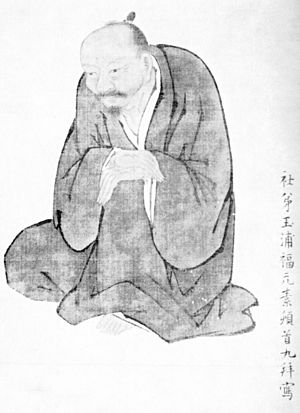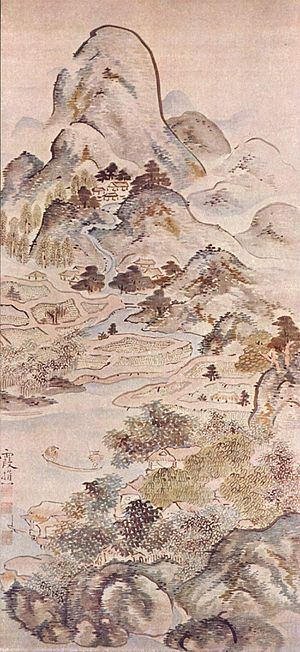Ike no Taiga facts for kids
Ike no Taiga (池大雅, 1723–1776) was a famous Japanese painter and calligrapher. He was born in Kyoto during the Edo period.
Ike no Taiga, along with Yosa Buson, helped make the bunjinga (or nanga) art style very popular. This style was inspired by Chinese art. Most of Taiga's works showed his love for old Chinese culture and painting methods. However, he also added new and modern ideas to his traditional paintings. As a bunjin (文人, a person who loves art, literature, and learning), Ike was friends with many important artists and thinkers in Kyoto and other parts of Japan.
Contents
Life Story of Ike no Taiga
Ike no Taiga was born into a family that wasn't very rich. His father was a farmer near Kyoto. His family moved into Kyoto before Taiga was born, possibly to find a better life. His father found a job at the silver mint, which gave the family a little money. Sadly, his father died when Taiga was only three years old.
Even though she was a widow, Taiga's mother managed to pay for him to have good teachers. He learned about classical Japanese and Chinese subjects. When he was six, he started learning calligraphy and religious lessons at the Manpuku-ji Zen temple. He stayed connected to this temple for his whole life.
Becoming a Professional Artist
By the time he was fourteen, Taiga was already a professional artist. He was also a very skilled calligrapher. He ran a small shop in Kyoto where he painted fans. He also carved seals for other artists and collectors.
A big moment for Taiga was meeting Yanagisawa Kien. Kien was a very important person in art and society at that time. This meeting helped Taiga enter the world of the bunjin.
Learning New Art Styles
Taiga studied painting and calligraphy with Kien starting in 1738. He really liked an old and unusual way of painting using fingertips and fingernails. He became good friends with two other bunjin students, Kan Tenju and Kō Fuyō. By the age of twenty (1743), Taiga saw himself as a full member of the literati. He shortened his family name "Ikeno" (池野) to "Ike," like how Chinese artists often used single-character names.
A Chinese painter named Yi Fujiu also influenced Taiga. Yi Fujiu taught Chinese literati painting. This style became a main inspiration for Ike no Taiga's art.
Marriage and Travels
In the early 1740s, Taiga returned to Kyoto and his fan shop. Even though the bunjin lifestyle meant avoiding business, Taiga needed money. So, he kept selling his art and services, just like his friend Yosa Buson.
In 1746, he married an artist and tea house owner named Gyokuran. They quickly became well-known in Kyoto's art world. Two years after getting married, Taiga began a series of journeys. Traveling was a big part of the bunjin way of life. He wanted to connect with nature, find new ideas for his art, and become a more cultured person.
He traveled through places like Kanazawa, Nikkō, and Mount Fuji. Then, he stayed in Edo for a while. There, he created paintings and calligraphy. He also learned about Dutch art from scholars who studied Western knowledge, called Rangaku. One of these scholars was Noro Genjō.
Later Life and Collaborations
Taiga continued to travel and climb mountains for most of his life. He often went with his bunjin friends. For a time, he used the art-name Sangaku Dōja (三岳道者), meaning "Pilgrim of the Three Peaks."
He often worked with his friends on art projects during these trips. One famous example is the Jūben jūgi-jō (Album of Ten Conveniences and Ten Pleasures). This album was made in 1771 by Taiga and Yosa Buson. It also included text by the Chinese writer Li Yu. The Jūben jūgi-jō celebrates a simple life and connecting with nature. Today, it is seen as a great example of the bunjin way of thinking.
Another artist who greatly influenced Taiga later in life was Hakuin Ekaku. Hakuin stayed at Taiga's home briefly in 1752. Even though they met only for a short time, Taiga started using parts of Hakuin's unique style in his own work. He then sought out many of Hakuin's students, working with them and writing on each other's art.
Some of Taiga's artworks are now considered National Treasures by the Japanese government. This shows how important his art is to Japan.
See also
 In Spanish: Ike no Taiga para niños
In Spanish: Ike no Taiga para niños



